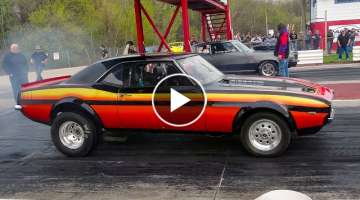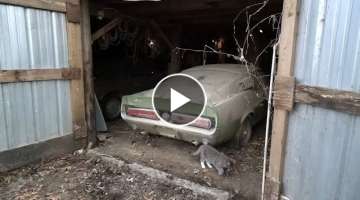1965 Chevrolet Corvette Coupe
Chevrolet introduced the iconic and revolutionary Sting Ray series in 1963. The styling was led by GM's chief of design, Bill Mitchell, assisted by many of the greatest and legendary names in American automotive styling. For the first time, one's Chevrolet sports car could be had either as an open-air roadster or a comfortable enclosed coupe. Unique features found on the 1965 model include the three vertical louvers on the bottom portion of the front fenders. 1965 was also the first year for all-wheel disc brakes for the Corvette.
At the 1964-1965 New York World's Fair, the General Motors Futurama Pavilion was the largest exhibit. It included the new Mako Shark II, a cutaway 1965 Sting Ray fuel-injected coupe and a cutaway Mark IV 396 engine. The Cutaway Engine display was powered by a starter motor and used to display all the major components, build quality, and overall operation of the mid-1965 introduction of the 396 CID engine. The engine offered 425 horsepower, more than any of the other 396 engines manufactured from mid-1965 until production ended in 1969. It was also the end for the Rochester fuel-injection system, as the carbureted 396/425 option cost much less than the fuel-injected 327/375. The fuel-injected Corvette was not produced after 1965, and the 396 was quickly replaced by the 427 to keep up with other automakers.
The all-new Mark IV big-block engine was a revolutionary design, with its high-strength cylinder block and excellent breathing, courtesy of GM engineer Richard 'Dick' Keinath's radical 'porcupine'-style valvetrain design. It provided massive power and scope for future development, and was a more advanced alternative to Chevrolet's existing W-head big-block 348/409 engine family. Clandestine development had begun in 1962 and heading the project was a veritable dream team of Chevrolet engineers and visionary executives who managed to work around General Motors' self-proclaimed racing ban that came in 1963.
The standard engine was a 327 cubic-inch V-8 with overhead valves, a cast-iron block, 10.5:1 compression, a four-barrel carburetor, five main bearings, hydraulic valve lifters, and developed 250 horsepower at 4,400 RPM and 350 lbs-ft of torque at 2,800 RPM. It was paired with a standard three-speed manual all-synchromesh transmission with a floor-mounted gear shifter. A two-speed Powerglide automatic with floor-mounted gear shifter was optional, as was a high-performance all-synchromesh four-speed manual, or a close-ratio four-speed manual. An optional version of the 327 CID (L75) engine delivered 300 horsepower and 360 lb-ft of torque. The L79 version of the 327 CID V8 with a Holley four-barrel carburetor produced 350 hp and 360 lb-ft of torque and the L76 327 CID V8 had 365 hp and 350 lb-ft of torque. The L84 327 CID V8 with Rochester Ram-Jet fuel injection produced 375 horsepower at 6,200 RPM and 350 lb-ft of torque at 4,000 RPM. The L79, L76, and L84 engines had 11.00:1 compression and a high-lift camshaft. The L79 had hydraulic valve liters while the L76 and L84 engines had mechanical valve lifters.
The mid-year 396 CID V8 had overhead valves, 11.00:1 compression, mechanical valve lifters, high-lift camshaft, five main bearings, a Hofour-barrel carburetor, and produced 425 horsepower at 6,400 RPM and 415 lbs-ft of torque at 4,000 RPM.
The third year of this body style looked quite similar to its two predecessors, retaining the graceful and wind-cutting design, and a snug comfortable interior. A closer look revealed a revised hood, a new grille, and for the first time, functional venting in the front fenders, which all represented marked improvements over previous models.
The fastback coupe was priced at $3,950 and the convertible at $3,215. The convertible was more popular with 15,377 units built compared to 8,187 of the fastback coupe. The convertibles had a choice of white, black or beige soft top and the interior colors were red, black, blue, silver, white, saddle, maroon, and green. Standard amenities on the 1965 Corvette included safety belts, heater, defroster, windshield washer, dual exhaust, tachometer, carpeting, electric clock, sun visors, and outside rearview mirror.
VIDEO
Facebook Comments































